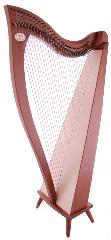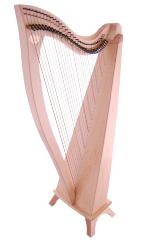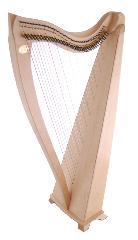Dusty Strings HarpsWhen Dusty Strings first began designing harps in 1984, their initial developments led to a combination of soundbox, soundboard construction and string design that gave a particularly bright, crisp and balanced sound. This sound, which serves a wide variety of playing styles well, has become a recognised characteristic of Dusty Strings harps. The Dusty Strings Range Introductory Range: Ravenna 26 (26 strings) and Ravenna 34 (34 strings) Experience and Innovation Blending the benefits of technology with the traditional woodworking techniques and tools of the craft of luthiery, Dusty Strings creates timeless high-quality musical instruments in a modern manufacturing environment. Special Features of Dusty Strings Harps Radiused Neck Joint The neck is held onto the top of the soundbox by string tension rather than bolts or screws. This way, the neck can flex under the tension introduced when the harp is strung, without compromising the strength and tightness of the joint between the neck and soundbox. The radiused joint also functions as a shock absorber, helping to dissipate the force of impact from minor bumps and falls. Threaded Tuning Pins Grooved with a very fine screw thread hidden inside the harp neck. When pressed into precisely sized holes, these threads create friction which securely holds the string's pitch. This also eliminates the occasional need to reset traditional tapered pins, which can work loose. Loveland Sharping Levers Brass with black polycarbonate coated cam handles for strength, smooth operation and virtually undiminished tone. A subtle touch of colour-coding on the C and F levers allows for easy identification and fluent lever changes. Camac Levers can also be fitted. |





